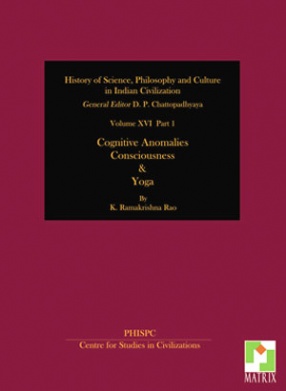Cognitive Anomalies, Consciousness and Yoga (Volume XVI, Part 1)
History of Science, Philosophy and Culture in Indian Civilization
Synopsis
Cognitive Anomalies, Consciousness and Yoga is Professor Ramakrishna Rao’s magnum opus, a culmination of life-long to develop a comprehensive model of the person that is inclusive or our rational, emotional and spiritual dimensions without reducing or converting one into another. Professor Rao brings his vast scholarship in eastern and western thought systems and his experience as a practicing scientist and psychologist for a unified understanding of human nature. His arguments move with ease from Upanishadic conceptions to current phenomenological and existential discourses on the mind and from quantum mechanics and practical physics to neural correlates consciousness.
Professor Rao sets out in the book with the primary question who we are. Are we merely brain-driven machines? Is consciousness no more than a pack of neurons firing in synchrony? Is there anything in us that does not fit into the material framework of the universe and calls for a paradigmatic shift in our search for a more inclusive universe?
These questions take him for an indepth discussion of paranormal phenomena, extraordinary human abilities. Pointing to the pervasive scientific evidence in support of such abilities that cannot be wished away as unreal artifacts of sloppy research nor explained adequately on materialistic/reductionist models, Professor Rao argues that the current research paradigms are simply inadequate to study these phenomena. Extensive discussions of current research on consciousness bring into focus certain aspects of consciousness that in principle appear to defy all attempts to explain them within the physicalist framework. Prominent among them is subjectivity, the “What is it like” feel of experience.
While acknowledging that physical models of the mind have contributed significantly to our understanding of cognitive abilities, Dr. Rao argues that they, however, leave many gaps in our knowledge of higher forms of consciousness. Professor Rao finds in Indian theories of mind and consciousness, especially Yoga, the necessary ingredients for a more comprehensive paradigm of human nature. From these ingredients, he develops the Trisula (Trident) model of the person as a compositive of body, mind and consciousness. Body-Mind-Consciousness nexus in humans is conceived as a single unitary process, and yet one that takes on quantum jumps and qualitative leaps as we move on from bodily processes to mental experiences and to conscious phenomena. Consciousness and mind are independent and irreducible to each other, and yet are manifestations of the same process. The irreducibility aspect tends to lead us to mistakenly hypostasize them as noninteracting entities. Their origin from a single source gives us the temptation to reduce them into a single category.
Cognitive Anomalies, Consciousness and Yoga are three books in one. Each part can be read as separate and distinctive. However, together they give a comprehensive picture of the person. This, indeed, is a source book of serious ideas that could provoke much further discussion and research.
Read more
Professor Rao sets out in the book with the primary question who we are. Are we merely brain-driven machines? Is consciousness no more than a pack of neurons firing in synchrony? Is there anything in us that does not fit into the material framework of the universe and calls for a paradigmatic shift in our search for a more inclusive universe?
These questions take him for an indepth discussion of paranormal phenomena, extraordinary human abilities. Pointing to the pervasive scientific evidence in support of such abilities that cannot be wished away as unreal artifacts of sloppy research nor explained adequately on materialistic/reductionist models, Professor Rao argues that the current research paradigms are simply inadequate to study these phenomena. Extensive discussions of current research on consciousness bring into focus certain aspects of consciousness that in principle appear to defy all attempts to explain them within the physicalist framework. Prominent among them is subjectivity, the “What is it like” feel of experience.
While acknowledging that physical models of the mind have contributed significantly to our understanding of cognitive abilities, Dr. Rao argues that they, however, leave many gaps in our knowledge of higher forms of consciousness. Professor Rao finds in Indian theories of mind and consciousness, especially Yoga, the necessary ingredients for a more comprehensive paradigm of human nature. From these ingredients, he develops the Trisula (Trident) model of the person as a compositive of body, mind and consciousness. Body-Mind-Consciousness nexus in humans is conceived as a single unitary process, and yet one that takes on quantum jumps and qualitative leaps as we move on from bodily processes to mental experiences and to conscious phenomena. Consciousness and mind are independent and irreducible to each other, and yet are manifestations of the same process. The irreducibility aspect tends to lead us to mistakenly hypostasize them as noninteracting entities. Their origin from a single source gives us the temptation to reduce them into a single category.
Cognitive Anomalies, Consciousness and Yoga are three books in one. Each part can be read as separate and distinctive. However, together they give a comprehensive picture of the person. This, indeed, is a source book of serious ideas that could provoke much further discussion and research.
151.20
136.08
$
168.00 $
Free delivery Wolrdwidе in 10-18 days
Ships in 1-2 days from New Delhi
Membership for 1 Year $35.00
Get it now and save 10%
Get it now and save 10%
BECOME A MEMBER
Books by the same author














Bibliographic information